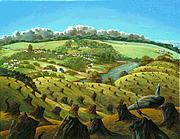
"Parramatta, 1815"
Oil on polyflax, 71 x 91 cm
SOLD
Maria and others disembarked from the Northampton, and were transferred to the Female Factory at Parramatta (far right in painting). The women slept rough on the factory floor or were permitted to find their own lodgings at night in the town. By 1815 the picturesque Georgian town had been created, with no understanding of the cost to the ecology of the land.
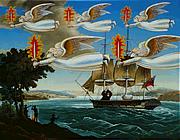
"When The Angels Came to Australia"
Acrylic on polyflax, 71 x 91 cm
SOLD
Using as reference-point the 'picturesque' painting by William Huggins of The Mellish Entering Sydney Harbour 1820, an overblown Rev. Samuel Marsden and sheep are accompanied by a squadron of angels, symbolic of the invading culture.
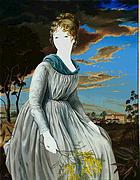
"The Unknowable Known"
Acrylic on polyflax, 71 x 91 cm
SOLD
This painting references the postmodern position that we cannot truly know the past. Convict records show Maria's height, eye-colour and hair colour. But they do not show us her physical features, nor is there any record left of her personal feelings or thoughts. Yet something of her blood runs through the veins of her descendants. This is intimate, inexpressible knowing.
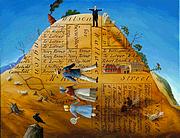
"Journey's End"
Oil on polyflax, 71 x 91 cm
SOLD
Circa 1840, Robert Roberts, Maria and Zillah came to live in Braidwood NSW. The 1839 survey map by James Larmer shows an allotment in Robert Roberts' name, fronting Wallace Street. The map also clearly shows the 'colonial grid,' which totally ignores the physical terrain - in this case a very steep hill. The 1840s brought the colony a prolonged drought, which contributed to the tragedy of the later life of the founder of the town, Thomas Braidwood Wilson. In 1844 Zillah married a local watchmaker.
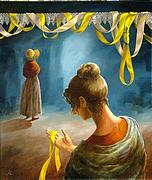
"The Nature of Temptation"
Oil on polyflax, 51 x 71 cm
$2,000
This painting depicts the moment in which Maria and her friend Rose Martin might have contemplated stealing the ribbon and lace which led to their conviction. They must have known the possible consequences of their action (which the artist has symbolised in the ribbon).
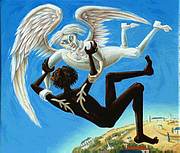
"Indigenous Spirit Wrestles With The Angel"
Oil on canvas, 61 x 71 cm
$2,000
The title is from a biblical reference - 'Jacob wrestling with the angel' - which western artists have often depicted. The painting alludes to the subjugation of indigenous spirituality by colonial Christianity.
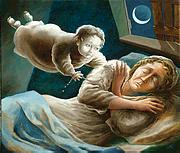
"Convict Dreams of Lost Child"
Oil on polyflax, 61 x 71 cm
$2,000
Her transportation separated Maria from her two Liverpool-born children, and as far as is known she was never to see them again. The broken string of pearls evokes the broken genetic line.
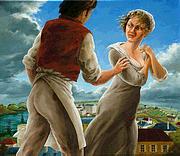
"The Proposition"
Oil on polyflax, 61 x 71 cm
SOLD
In 1815 Maria was assigned to the large warehouse/boarding house of Simeon Lord (visible in the centre of the painting) where she met James Briley (transported for signing workers to a union). As they were both already married, they formed a de facto relationship.
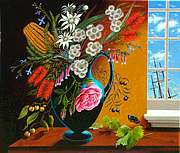
"Where Am I?"
Oil on canvas, 61 x 71 cm
SOLD
The title quotes Julie Szego (The Age Review, 2/8/03), from her article which deconstructs the current fashion of researching genealogy:
History has to get personal to be compelling. We look at momentous events through a solipsistic prism, asking "Where am I?"
This painting references colonial flower painting from W. B. Gould to Ellis Rowan. The 'vessel as woman' holds the English rose and her two children, whilst the native flowers represent the multitude of Australian descendents. The vine traditionally represents lineage, and the moth mortality.
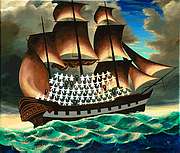
"Statistics: The Seventy Children of The Northampton"
Acrylic on polyflax, 61 x 71 cm
$2,000
Although Maria was not allowed to bring her children with her, there were in fact seventy children who accompanied convict and free mothers on this voyage. Seventy children endured the confined space of the sailing ship for the five-month journey (stopping only once, in Rio). Ten percent of the children died on the voyage.